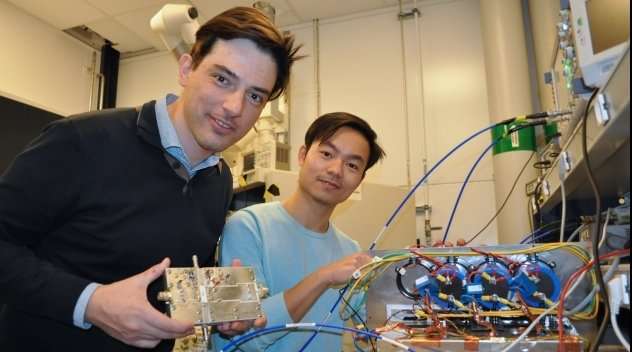Improved amplifier technology for use in positron emission tomography

In the EU project ENEFRF, researchers at the Ångström Laboratory are working on improving the radio frequency amplifiers that will make technology for cancer diagnostics more efficient, accessible, and affordable. "We are seeing a dramatic increase in the number of PET scans and therefore the costs for society. With upgraded technology, the costs for maintenance and operation will be reduced," says Dragos Dancila, Docent in Applied Physics.
Uppsala University has a long tradition of developing advanced technology for medical purposes. It was in Uppsala that 61 years ago a tumour was treated for the first time using proton radiation at the Gustaf Werner Institute for Nuclear Chemistry, GWI, todays The Svedberg Laboratory, TSL. Now researchers at the Ångström Laboratory are developing high-performance radio frequency amplifiers for medical imaging technology such as cancer diagnostics.
Dragos Dancila at the Division of Solid State Electronics and FREIA is heading the Eurostars project ENEFRF. The plan is to develop radio-frequency amplifiers for new cyclotrons in collaboration with GE Healthcare in Uppsala. Particle accelerators like cyclotrons are used to produce radio isotopes. These are then used as markers in positron emission tomography, PET, scans, to track and identify tumors in patients.
However, the electron tube technology used today relies on a single element, which is problematic in terms of reliability, states Dragos Dancila.
"If this component fails, it takes a long time to restore operations. But if instead we use more components, in the form of several dozen high power transistors, it will be easier to replace any single component, and in this way maintain radioisotope production."
Can be handled by hospital staff
Another advantage is that transistors with lower voltage levels can also be handled by staff without specialist knowledge. The result of the project is also more affordable cyclotrons which can even be dispatched to remote areas, according to Dragos Dancila.
"Then you can set up several cyclotrons near very many patients at different hospitals, instead of just having a single centralized cyclotron."
The radio frequency amplifiers that he and his research colleagues are developing at the Ångström Laboratory will be powered by transistors with a ten times higher density than is now available. They will however need to increase power levels.
"Right now, we are developing power amplifiers based on semiconductor technology for different frequencies and research on improving efficiency. The challenge is to reach high enough voltage levels and get the amplifiers to work with as high efficiency and reliability as possible," says Dragos Dancila. He adds:
"In the future, this kind of high-performance microwave sources will also be critical for the operation of research facilities such as ESS in Lund."
ENEFRF stands for Energy Efficient Positron Emission Tomography (PET) Cancer Diagnostics-Novel RF Source for Radioisotope Production.
The objective of the project team at the FREIA laboratory is to achieve more than 1 kW per transistor amplifier with approximately 80 percent efficiency.
The continuous improvement of the transistors allows a substitution of electron tube technology in the frequency range 100-2000 MHz.
Provided by Uppsala University




















